Apodasmia similis (Oioi, Jointed Wire Rush)
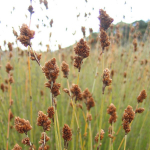
Apodasmia similis, commonly called oioi, is an attractive wetland reed with fine grey-green leaves and brownish bracts at the joints. Popular structural landscaping plant. A great option for mass planting on wet or coastal sites, growing in extremes of wind and salt.
A hardy plant tolerant of most soil types that is often used in riparian plantings. Plant communities that include Carex maorica, Carex secta, Carex virgata, Carex geminata, Phormium tenax and Eleocharis acuta often include Apodasmia similis. Recently, Apodasmia similis has become popular in landscape designs as it has an interesting texture and survives in a range of positions and is an easy NZ natives solution to wet or dry problem areas.
Habitat: Mostly coastal in estuaries, saltmarshes, dunes and sandy flats and hollows. Occasionally inland in gumland scrub, along lake margins, fringing peat bogs or surrounding hot springs.
Flowering: Spring [October - December]
Fruiting: Summer [December - March]
Tags: DrainField, ErosionControl, Rongoa, Wetland
Austroderia richardii (Toetoe)
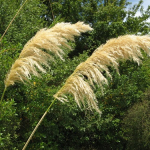 Sold Out
Sold Out
Austroderia richardii, commonly known as toetoe, is a large perennial tussock grass species that is native to New Zealand. It belongs to the family Poaceae and is endemic to the country, meaning it is found nowhere else in the world.
Austroderia richardii has distinctive features that make it easily recognizable as its one of the tallest grass species in New Zealand. The leaves are long and narrow, with a rough texture, and can grow up to 1.5 meters in length. The leaf margins are often serrated or toothed, giving them a slightly serrated appearance.
Austroderia richardii is typically found in wetland habitats, such as swamps, bogs, and riverbanks, although it can also occur in other types of habitats, including coastal dunes and forest clearings. It is an important plant for wetland ecosystems, providing habitat and food for a variety of birds, insects, and other wildlife.
Toetoe has been used by Māori, the indigenous people of New Zealand, for various purposes. The leaves have been used for weaving, thatching, and as bedding material, while the flower heads have been used for decorative purposes. Today, Austroderia richardii is also cultivated as an ornamental grass in gardens and landscaping due to its impressive size and striking appearance.
Overall, Austroderia richardii, or toetoe, is a prominent grass species in New Zealand, known for its tall stature, feathery flower heads, and importance in wetland ecosystems and cultural uses. A very tough, hardy and fast growing withstanding strong winds, costal conditions, drought and cold conditions.
On farm, Austroderia richardii is a good wind break once established as they grow in clumps and are very hardy plants that can withstand many weather conditions. Protects stock and stays below pivot irrigation, also useful in runoff prevention and along water courses. Toe toe is an attractive bank stabilisation plant, good for a range of soils and suits riparian plantings.
Habitat: Abundant, from the coast to subalpine areas. Common along stream banks, river beds, around lake margins, and in other wet places. Also found in sand dunes.
Flowering: Spring [September - November]
Fruiting: Summer [October - March]
Tags: Coastal, DrainField, ErosionControl, Rongoa, Wetland
Carex testacea (Speckled Sedge, Orange Sedge)
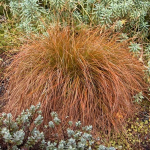
Carex testacea, commonly known as Orange or Speckled Sedge, is a clump-forming perennial grass-like plant that belongs to the family Cyperaceae. It is native to New Zealand and is widely cultivated as an ornamental plant in many parts of the world.
Carex testacea is known for its distinctive foliage, which undergoes color changes throughout the year. The leaves are typically narrow and linear, and they emerge in shades of green, gradually turning to a warm bronze, copper, or orange color as they mature. The foliage has a fine, hair-like texture, which gives the plant a unique and ornamental appearance.
The plant typically grows in dense tufts or clumps, with stems that are typically upright or slightly arching, reaching a height of 30 to 60 cm. The stems are usually smooth and glossy, and they may develop a reddish coloration towards the base.
Carex testacea is a relatively low-maintenance plant that is tolerant of a wide range of growing conditions. It prefers well-draining soils and can tolerate partial to full sun, although it may exhibit more intense coloration in brighter light. It is drought-tolerant once established, making it suitable for water-wise gardens. Evergreen. Hardy.
Habitat: Coastal to montane. In sand dunes, coastal forest and scrub, dense forest or short tussock (Festuca novae-zelandiae) grassland.
Flowering: Spring [September - December]
Fruiting: Summer [December - May]
Carmichaelia australis (Makaka, Common Broom)
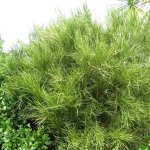
Carmichaelia australis, commonly called Common Broom or Makaka, is a small to large shrub with spreading erect and flattened to round photosynthetic stems. Meaning that instead of leaves the stems are flattened to catch the sunlight. It is a hardy fast growing upright broom. From spring through to summer, it has small 5-6 mm white flowers with purple veins and sometimes has purple centres. The seeds are yellow, orange or red often with black dots. The seeds are distributed when the seedpod bursts so the seed travels only short distances, compared to wind and bird-dispersed seed. Attractive to bees. Evergreen. Prefers full sun and tolerates dry, windy and cold sites. Hardy.
Habitat: Coastal to montane, on river terraces, stream banks, colluvium, rock outcrops, talus and fan toe slopes, among tussock grassland and grey scrub, on the edge and margins of dense bush, forest, and in swamps.
Flowering: Spring - Summer [October - February]
Fruiting: Summer - Autumn [November - May]
Tags: RarePlant
Coprosma acerosa (Tataraheke, Sand Coprosma)
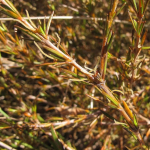
Coprosma acerosa, or sand coprosma, is a groundcover that is found naturally near the coast throughout New Zealand. Great for windy, coastal areas which get dry winds. The small needle-like deep green leaves clothe the intertangling branches that form springy mounds with a spread of up to 1m. Useful grown in areas prone to erosion, on banks, or over walls. Can also be easily incorporated into mixed shrub planting as a ground cover. In addition to bank stabilisation and as a mixed groundcover, native gecko species love the berries. As a result, this is a good addition to a revegetation project looking to increase biodiversity in the area. When plants of both sexes are present, attractive smoky blue berries follow the tiny green flowers. This is an excellent plant for coastal areas and hot dry conditions.
Habitat: Coastal sand dunes.
Flowering: Spring [September - December]
Fruiting: Autumn [February - May]
Tags: ErosionControl, PoorSoils, Rongoa
Coprosma crassifolia (Mingimingi)
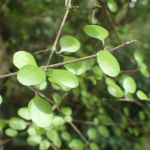
Coprosma crassifolia, commonly called mingimingi, is a stiffly-branched upright shrub with small dark-green leaves and white to pale-yellow berries that attract skinks and birds. It's a tough shelter and revegetation shrub for drought-prone sites. The upright, columnar habit is good for narrow spaces.
In the forest, the shrub is sparsely branched but in the open, it forms densely branched thickets. The stiff, more or less round remote leaves and the stiff, red-brown branchlets distinguish C. crassifolia from all other Coprosma species. The flowers are unisexual. The berries flesh is transparent but look white due to the white seed within. They may also look pale yellow.
Habitat: Coastal rocky and sandy lowland to lower montane shrubland and forest, up to 600 m.
Flowering: Spring [September - October]
Fruiting: Summer - Autumn [November - June]
Coprosma propinqua (Mingimingi)
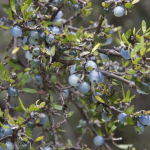
Coprosma propinqua, commonly known as Mingimingi, is a species of evergreen shrub or small tree that is native to New Zealand. It belongs to the family Rubiaceae and is known for its distinctive foliage and attractive appearance.
Coprosma propinqua exhibits a compact and bushy growth habit, typically reaching a height of 1 to 3 meters. The leaves are opposite, simple, and small, measuring about 1 to 3 centimeters in length. The leaves are elliptical or lanceolate in shape, with smooth margins, and are usually glossy and dark green in color. Some varieties may have variegated leaves with contrasting colors, such as yellow or cream markings.
The flowers of Coprosma propinqua are small and inconspicuous, typically greenish or yellowish in color. They are borne in clusters and are not particularly showy. The plant is dioecious, which means that male and female flowers are borne on separate plants.
The fruit of Coprosma propinqua is a fleshy drupe, typically spherical or ovoid in shape, and about 5 to 7 millimeters in diameter. The fruit initially appears green, but matures to a dark purple or black color when ripe. The fruit is often eaten by birds, which help to disperse the seeds.
Coprosma propinqua is commonly found in various habitats in New Zealand, including forests, shrublands, and coastal areas. It is known for its ability to tolerate a wide range of growing conditions, including poor soils and exposure to salt spray, making it a hardy and adaptable plant. It is also known to have medicinal properties and has been used traditionally by Maori for various purposes.
In cultivation, Coprosma propinqua is often used as an ornamental plant in gardens and landscapes due to its attractive foliage and low maintenance requirements. It can be grown as a standalone specimen plant, or used as a hedge or ground cover. It is typically propagated by seeds or cuttings, and prefers well-drained soils and a sunny to partly shaded location.
Habitat: Found in lowland forest, along forest margins and streambanks, in scrub, gravelly places and along the edges of bogs and swamps.
Flowering: Spring [October - November]
Fruiting: Autumn [March - May]
Tags: Coastal, DrainField, PoorSoils, Rongoa, Wetland
Coprosma robusta (Karamu)
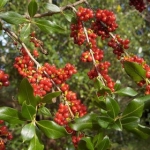
Coprosma robusta, Karamu, is a fast-growing shelter, hedging and nurse plant. Competes well with gorse. Laden with bright-orange fruit/seeds March-July. As with other Coprosma species, their berries are ideal for attracting birds, especially bellbirds, tuis and waxeye. This is one of the many reasons why Coprosma robusta is a pioneer revegetation species. Its wide, bright green leaves are thick, smooth, and shiny. Can be confused with C. lucida. Shade tolerant. Suits low-frost sites. Evergreen.
History of use: Karamū is used for a variety of purposes in human culture. The fruit that Coprosma robusta produces can be eaten, and the shoots of Karamū are sometimes used for medical purposes.
Habitat: Common throughout coastal, lowland and lower montane habitats within shrublands and open sites within forest.
Flowering: Spring [August - November]
Fruiting: Autumn [February - May]
Tags: ErosionControl, Rongoa
Cordyline australis (Ti Kouka, Cabbage Tree)
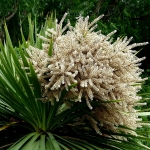
Cordyline australis, Ti Kouka, commonly called Cabbage Tree, is one of the most identifiable New Zealand native plants in the landscape. It has a tall straight trunk or trunks and a dense round head, with a sphere of long narrow leaves. Cabbage tree produces a profusion of attractive and scented flowers in spring. It is an abundant seeder. It looks most natural in the ornamental garden if planted in groups. Three or more plants can be planted together in the same hole to produce this effect. It grows in all soils and situations, even in swampy ground, where little else of interest will grow.
Cordyline australis is a light-demanding pioneer species, and seedlings die when overtopped by other trees. To grow well, young plants require open space so they are not shaded out by other vegetation. Its fruit and nectar are a favourite food source for kererū and tūī. Bellbirds like to nest in Tī Kōuka. Some lizards forage among the flowers of Cordyline australis and the nectar of the flowers is sought after by insects.
History of use: The Maoris obtained a most nutritious food, kauru, from the root of the young cabbage tree. This root is an extension of the trunk below the surface of the ground and is shaped like an enormous carrot some 2–3 ft long. An observer of the early 1840s, Edward Shortland, noted that the Maoris “prefer those grown in deep rich soil; they have learned to dig it at the season when it contains the greatest quantity of saccharine matter; that is, just before the flowering of the plant. They then bake, or rather steam it in their ovens. On cooling, the sugar is partially crystallised, and is found mixed with other matter between the fibres of the root, which are easily separated by tearing them asunder, and are then dipped in water and chewed”. The trunk of the cabbage tree is so fire-resistant that early European settlers used it to make chimneys for their huts. They also brewed beer from the root.
Medical Uses: An infusion of the leaves was used for dysentery and diarrhoea and for cuts. (From "Maori medical lore" by W. H. Goldie. 1905) The leaves were softened by rubbing and scraping. These scrapings were applied as an ointment to cuts, cracks in the skin and sores (from unpublished notes by Beryl Moore 1940). The younger inner shoots and the top of the stem were boiled and eaten by nursing mothers and were given to their children for colic. (From unpublished notes by T. Kururangi 1941)
Habitat: Widespread and common from coastal to montane forest. Most commonly encountered on alluvial terraces within riparian forest.
Flowering: Spring [October - December]
Fruiting: Summer - Autumn [January - April]
Tags: Coastal, ErosionControl, Rongoa, Wetland
Corokia cotoneaster (Korokio)
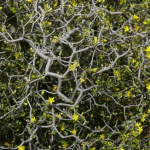
Corokia cotoneaster, or Korokio, is a good hedging and ornamental shrub. Corokia cotoneaster prefers to survive in areas that are not wet. It will grow and develop in dry, rocky, and dense soils. Attractive fine silver/grey foliage with bright yellow flowers in early summer. Densely interlaced branchlets. Red berries/seed. Evergreen. Very hardy to drought and cold.
As it is a tough plant that attracts birds and lizards, it is suitable for restoration projects. As part of the dry woodland community, it plays an important role in conditioning the soil. The soil conditioning creates a more hospitable environment for less robust species and broadleaf/podocarp forest succession. Other plants in this community include but are not limited to Discaria toumatou, Poa cita, Ozothamnus leptophyllus, Sophora prostrata, Melicytus alpinus and Cordyline australis.
Habitat: Found in scrub and on dry river flats and rocky places throughout the country.
Flowering: Spring [September - December]
Fruiting: Summer - Autumn [January - May]
Tags: DrainField, PoorSoils
Cyperus ustulatus (Upoko-Tangata, Giant Umbrella Sedge)
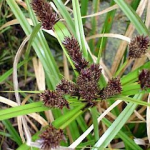 Sold Out
Sold Out
Cyperus ustulatus, giant umbrella sedge, is a fast growing sharp-edged swamp grass with olive green leaves. Ideal for wetland re-vegetation. Quick to colonize damp areas which will eventually establish tall swamp forests. The arching dark green foliage is complemented with green flowers in summer which age to a showy brown.
History of use: Colenso 1869 reported that the Maoris stripped off outside edges of the leaves and use them for mats, baskets and for kite making. An upoko-tangata kite was featured on a set of matariki (Maori New Year) stamps issued by New Zealand Post in 2010. They also use the leaves as an outer thatch on their whares (dwellings). Medically the pith was boiled with water, strained and used in the North Auckland districts for kidney trouble (Adams 1945).
Habitat: Coastal to lowland sites in open ground. Tolerant of a wide range of habitats and conditions but evidently preferring wetland margins, seepages, streamsides, lagoon and estuary margins.
Flowering: Spring - Summer [July - December]
Fruiting: Summer - Autumn [July - April]
Tags: DrainField, Rongoa, Wetland
Discaria toumatou (Matagouri)
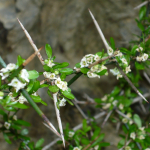
Discaria toumatou, commonly called Matagouri, is a tangle-branched, extremely thorny, divaricating shrub or small tree up to five metres tall. It has small leathery leaves close to the thorns, which are only abundant in spring or the shade. The flowers are tiny and white with no petals. It is the only New Zealand native plant that has thorns. Nitrogen-fixer. Common in dry shrublands of the eastern South Island.
It is most common in tussock grassland, stony areas and river beds. It is common in the eastern South Island, and found in a few coastal localities in the North Island south from the mouth of the Waikato River. As with other Discaria species it fixes nitrogen from the atmosphere with the help of symbiotic bacteria of the genus Frankia in its roots. It often grows in association with mingimingi (Coprosma propinqua), porcupine shrub (Melicytus alpinus, an alpine mahoe) and native brooms (Carmichaelia species). Seeds are dispersed by ballistic projection and water.
As a native plant matagouri has complete protection on public conservation land and a degree of protection on private land under the Resource Management Act 1991. In a notable case a 400 ha area of matagouri forest, including trees that may have been 150 years old, was illegally sprayed at the head of Lake Sumner in 2001.
Habitat: Found in dry riverbeds, open rocky places and sand dunes from coastal to subalpine.
Flowering: Spring - Summer [October - January]
Fruiting: Summer [December - March]
Tags: Rongoa
Disphyma australe (Horokaka, Coastal Ice Plant)
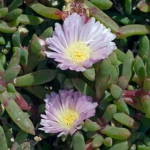
Disphyma australe, Horokaka, commonly known as the NZ Native Ice Plant, this is a fast-growing groundcover that is found naturally along coast lines. Plants carry thick and succulent leaves which enable it to survive extended periods of dry. It features pale pink and white daisy-like flowers in summer that open and close with the sun. This succulent typically grows to 20 cm tall and 50 cm wide, preferring a full sun position with good drainage. This plant is commonly used as a groundcover where it can grow over rocks or planted to spill over the edge of retaining walls. It also makes for a fantastic indoor plant and is well suited to planting around outdoor living areas. It is often included in coastal plantings to help retain sand. Please note that plants can be frost sensitive when young.
History of use: Early Europeans pickled the leaves and the ripe fruit was eaten raw. Maoris treated boils with juices from the leaves.
Habitat: It is a coastal plant and is rarely found inland. Mostly found on cliff faces, rock stacks, and boulder/cobble beaches, more rarely in saltmarsh and estuaries. Often in petrel scrub on offshore islands, and extending into coastal forest around petrel burrows. Often where seabirds nest it is the only plant growing.
Flowering: Present throughout the year
Fruiting: Present throughout the year
Tags: Rongoa
Dodonaea viscosa (Ake Ake)
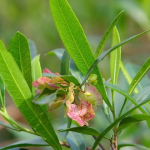 Sold Out
Sold Out
Dodonaea viscosa, commonly called Akeake, is an ornamental small bushy erect tree. Attractive brown flaky bark. The long shining leaves are bright green and dense on erect branches. The seed capsule is most attractive in the autumn. Wind resistant, and grows in coastal sites. Good for shelter in light sandy soils.
Habitat: Coastal to lowland forest, occupying a range of habitats from dunefields and boulder beaches through coastal scrub to lowland forest. Rarely forming a dominant tree in coastal forest.
Flowering: Spring - Summer [September - January]
Fruiting: Summer - Autumn [November - April]
Tags: Rongoa
Festuca novae zelandiae (Hard Tussock)
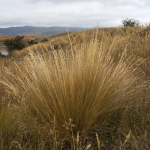
Festuca novae-zelandiae is a fine-leaved tawny tussock, upright in habit. A common component of low tussock grasslands on dry, windy and cold plains in Canterbury & Otago. It is deep rooted and dominant on steep, exposed slopes. In alpine areas at lower altitudes Festuca novae-zelandiae is associated with the narrow-leaved snow tussock (Chionochloa rigida). Stunning grass en masse. Needle thin erect leaves green to blonde. Tolerates poor soil and dry conditions.
The tawny leaves are 15-60cm long and have a width of 0.5-1mm. They are rough to touch and have sharply pointed tips. The margins are tightly in rolled giving the leaf a cylindrical appearance. The flowering stems are up to 70 cm tall with a 5-12 cm long open flowering panicle.
Habitat: Short tussock grasslands. Pre-1900s short tussock grassland covered considerable areas of the eastern South Island from sea level up to between 800 and 900 metres high.
Flowering: Spring [September - November]
Fruiting: Summer [December - February]
Tags: PoorSoils
Griselinia littoralis (Kapuka, Broadleaf)
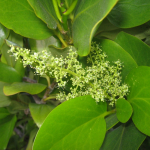
Griselinia littoralis, Kapuka or Broadleaf, is a very hardy evergreen tree. With regular trimming it makes a popular and effective hedging shrub. Grows in a range of soil types but prefers well-drained soil in full sun. Can tolerate frost and wind. It is useful in coastal situations (littoralis means shore growing) as it will tolerate frost, rough winds and salt spray. It is also a good upper bank plant for riparian plantings.
The oval leaves are leathery glossy and lush bright green. This plant produces small cream insignificant flowers that attract native pollinators. The tiny green and yellow flowers are also a good source of pollen for bees in the spring. In autumn the female trees have small purple-black fruit which tui eat.
History of use: It was an opening medicine and the inner bark was used on scrofula (a tuberculous infection of the skin on the neck). The timber was known for its durability.
Habitat: Found in lowland forests to subalpine scrub.
Flowering: Summer [November - January]
Fruiting: Autumn - Winter [February - August]
Tags: Rongoa
Hoheria angustifolia (Houhere, Narrow-leaved Lacebark)
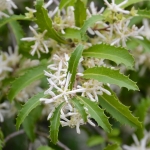 Sold Out
Sold Out
Hoheria angustifolia, Houhere, commonly known as Narrow-leaved Lacebark, is a tree native to New Zealand. It is a member of the family Malvaceae and is known for its striking appearance, with its slender leaves and attractive flowers. The leaves of Hoheria angustifolia are narrow and lanceolate.
The flowers of Hoheria angustifolia are one of its most distinctive features. They are typically large and showy, measuring 1.5-2 cm in diameter and arranged in clusters at the tips of the branches. The flowers are usually white and fragrant, and attract pollinators such as bees and butterflies.
The bark of Hoheria angustifolia is smooth and greyish-brown when young, becoming rougher and more fissured with age. The bark peels off in strips, revealing a lighter colored inner bark, which adds to its aesthetic appeal.
Hoheria angustifolia is primarily grown as an ornamental tree in gardens and parks, appreciated for its graceful form, attractive flowers, and interesting bark. It is also used in ecological restoration projects for its ability to attract pollinators and provide habitat for birds and insects.
History of use: The inner bark of Hoheria angustifolia has been used traditionally by Maori for making rope and twine.
Habitat: A common mostly lowland forest species frequenting alluvial forest where it may at times be dominant. Hoheria angustifolia is often an important host for taapia (Tupeia antarctica).
Flowering: Summer [December - March]
Fruiting: [February - April]
Tags: Rongoa
Juncus edgariae (Wiwi, Edgars Rush)
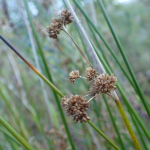
Juncus edgariae, or Wiwi, is a common rush of swampy areas throughout New Zealand. Grows in tight clumps with bright-green stems. Useful for wet areas and revegetation of wetlands, but will tolerate dry conditions for short periods. Evergreen. Hardy.
Often found in plant communities that include but are not limited to Apodasmia similis, Carex maorica
Carex secta, Carex virgata, Phormium tenax, and Eleocharis acuta.
Habitat: Easily the most common indigenous species. Coastal to alpine (1600 m a.s.l.) but mainly coastal to montane. Usually in open shrubland, fringing wetlands, and in seasonally damp sites. Often found invading pasture and in urban areas.
Flowering: Spring - Summer [October - December]
Fruiting: Summer - Autumn [November - April]
Tags: Wetland
Kunzea ericoides (Kanuka)
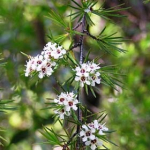
Kunzea ericoides, Kanuka tree, is a fast growing tree found throughout the north of the South Island. The leaves are softer to touch than Manuka and has smaller white flowers in Summer. It is very hardy, tolerating drought, frosts and poor soils. It is a primary colonising plant and used for revegetation as a nurse plant. Both manuka and kanuka are used as a nurse crop with other early colonizing plants for revegetation / restoration planting and are also very effective in erosion control. It is fast-growing, but short-lived, living up to 150 years. A juvenile takes about seven years to reach reproductive maturity. Very hardy.
History of use: The name "tea-tree" comes from the early bushman who used Manuka and Kanuka leaves to brew a drink similar to tea. Captain Cook was the first person to brew tea from manuka and said that it had a very agreeable, bitter taste when made with fresh leaves, but lost some of it piquancy when made with dry leaves. Kanuka leaves produce a tea that isn't quite as flavourful. Both tea-trees supposedly have medicinal uses and properties whose benefits far outweigh any considerations of taste. The leaves, brewed in water, help urinary complaints and reduced fevers.
The Maori and early settlers used to chew young shoots or swallow a drink made from seed capsules as a cure for dysentery and diarrhoea. The liquid from boiling the bark was used to treat constipation, as a sedative to promote sleep and reduce fever, for bathing sore eyes, treating colic, inflamed breasts, scalds and burns. The white gum was applied to scalds and burns and was taken by adults and children to relieve coughing. There are much more medicinal uses to which tea-tree was put to. Kanuka flowers produce a reasonable amount of nectar that is quite favoured by honeybees. The thick golden honey is hard to remove from honeycombs, but is quite popular for its strong taste and reputed antibacterial properties. Nowadays New Zealand’s monofloral Manuka and Kanuka pharmaceutical honey are both renowned for their natural health benefits.
The tough wood was used by Maori for implements such as fern root beater, mauls, paddles, weapons, spade blades, weeders, digging sticks and bird spears. The timber was noted for its straight grain, durability and strength by early European settlers, and was in demand for wheel-spokes, tool handles and other such purposes. Kanuka and Manuka wood is commonly used as firewood, especially for barbeques, or charred into charcoal. Older trees of have their trunks covered with a light brown bark that readily strips off, and is frequently used for fire-kindling. Both Manuka and Kanuka branches have been used to make brush brooms.
Habitat: Coastal to lowland shrubland, regenerating forest and forest margins, also present in montane forest, ultramafic shrubland and very occasionally present in subalpine shrubland.
Flowering: Spring - Summer [September - February]
Fruiting: Autumn [March - April]
Tags: ErosionControl, PoorSoils, Rongoa
(Taxonomists recently confirmed that K ericoides, K robusta, and K serotina are all the same species and declared all South Island Kānuka Kunzea ericoides.)
Leptinella dioica (Shore Cotula)
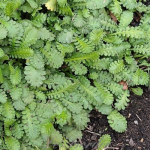
Leptinella dioica is an herbaceous perennial native to New Zealand. It is a creeping and somewhat fleshy plant that bears small and green, fern-like leaves with a touch of bronze. Small, yellow flowers are borne through spring and summer amidst the foliage. It typically grows to 10 cm tall and 70 cm wide, growing best when planted on a well-drained site in full sun or partial shade. This hardy plant has storage roots which enable it to survive moderate frosts, dry periods, and coastal environments. This is a great plant to use as a low groundcover, for planting between rocks and pavers, using in tropical gardens, or planting around pool areas. Can be used as a lawn substitute in low traffic areas which are seasonally damp or somewhat poorly drained. Tolerates sun, wet and dry periods and salt water. Will grow on clay banks. Evergreen. Hardy.
Habitat: Coastal and inland up to 1000 m a.s.l.. In the northern part of its range usually on the margins of saltmarshes but further south extending well inland in seepages and permanently open, damp turfs.
Flowering: Spring - Summer [August - January]
Fruiting: Summer - Autumn [October - June]
Tags:
Leptospermum scoparium (Manuka, Tea Tree)
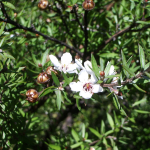
Leptospermum scoparium, the Manuka tree (or Tea Tree), is a fast growing shrub with abundant white flowers in Summer. The flowers are attractive to bees. Both manuka and kanuka are used as a nurse crop with other early colonizing plants for revegetation / restoration planting and are also very effective in erosion control.
Mānuka is often confused with the related species kānuka (Kunzea ericoides) – the easiest way to tell the difference between the two species in the field is to feel their foliage – mānuka leaves are prickly, while kānuka leaves are soft. Alternatively, the seed capsules of mānuka are large (5–7 mm in diameter) and often remain on the plant year round, whereas the seed capsules of kānuka are much smaller (2.2–4.6 mm in diameter) and are not present for much of the year.
History of use: The wood was often used for tool handles. Mānuka sawdust imparts a delicious flavour when used for smoking meats and fish. It is cultivated in Australia and New Zealand for mānuka honey, produced when honeybees gather the nectar from its flowers, and for the pharmaceutical industry. An essential oil, for which many medicinal claims are made, is produced by steam distillation of its leaves.
Habitat: Abundant from coastal situations to low alpine habitats.
Flowering: Spring - Summer [September - March]
Fruiting: Autumn - Summer [Throughout the year]
Tags: ErosionControl, Rongoa, Wetland, WinterPollen
Melicytus alpinus (Porcupine Shrub)
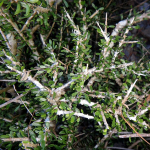
Melicytus alpinus get their common name, porcupine shrub, from the long, almost leafless, spindly branches which resemble the quills of a porcupine. Its leaves are narrow and generally have smooth margins with a few exceptions with serrated edges, however, they do only have a small amount of leaves and they are only approximately 1cm long. Hard and dense, slow-growing in coastal or alpine areas of southern North Island and the South Island it looks almost leafless. But most of the leaves are sheltered between the stiff interlacing stems as an adaptation to the harsh environment where the plant grows. Leaves are variable, leathery.
Melicytus alpinus is very well adapted to extreme weather conditions such as drought, which is why it can be found in areas such as the heavily modified high country of the South Island.
Melicytus alpinus is a habitat to many lizards endemic to New Zealand, this group of lizards include both skinks and geckos. This relationship is mutually beneficial as the lizards use the porcupine shrub as protection from weather and/or predators and in turn eat and spread the seeds from the shrub's berries.
Habitat: Occurs east of the Southern Alps in exposed rocky places between 600m and 1.300m. Found in the wild on very light sand or rocky soils, or on rock outcrops in full sun though it grows on any well-drained soil.
Flowering: Summer [November - January]
Fruiting: Autumn [February - April]
Tags: RarePlant
Melicytus ramiflorus (Mahoe, Whiteywood)
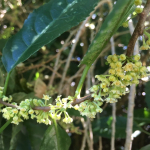
Melicytus ramiflorus, commonly known as Whiteywood or Mahoe, is one of our most common trees, found in forest and shrub throughout New Zealand and growing quickly to 5m or more. The pointed oval leaves are a bright green, with fresh growth being quite soft and an even brighter green. The bark is greyish white and becomes attractively mottled with lichens. Flowers in spring followed by numerous purple black berries. Whiteywood can be clipped for hedging or used as a shelter tree or filler, and will also make quite an attractive specimen. Avoid heavy frosts when young.
The berries of Māhoe are eaten by a number of native birds, including kererū and tui, and some geckos. It is frequently seen in areas of regenerating forest, particularly in areas of disturbed soil. Its early appearance in regenerating forests indicates that it is ideal for revegetation plantings.
Habitat: Abundant small tree of coastal, lowland, and lower montane forests throughout the country.
Flowering: Spring [November - February]
Fruiting: Summer [February - April]
Tags: Rongoa
Muehlenbeckia astonii (Pohuehue)
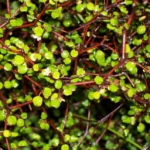 Sold Out
Sold Out
Muehlenbeckia astonii, Pohuehue, is a coastal divaricating shrub with a wiry interlacing habit. Small, bright-green heart-shaped leaves. This plant is extremely hardy, tolerating dry conditions and wind. Popular landscaping plant, providing great contrast. Makes an attractive topiary or hedge. Attracts birds, insects and lizards. Semi-deciduous. Hardy.
Unlike most New Zealand plants M. astonii is leafless in winter. This is when the distinctive branches add interest to the garden. It grows from a distinct trunk and has many fine reddish-brown to orange flexible branches that zigzag around one another to form a dense, interwoven ball. Its flowers, appearing from December to January, are tiny and are greenish to white or pinkish white. The fruits are sweet and edible, eaten by birds and lizards. The plant is an important host for several endemic insect species and in some cases their sole host.
Habitat: Coastal to lowland. This species is associated with “grey” scrub communities, largely confined to drier lowland parts of eastern New Zealand. It is found on moderate to high fertility soils. Its deep root system helps it survive in dry conditions, and can grow on open rocky hillsides and stony ground. It prefers free-draining, warm, sunny slopes, such as the mid-dune areas along the coast. The plant is often found in association with Coprosma crassifolia, Coprosma propinqua, Muehlenbeckia complexa, Discaria toumatou, Olearia solandri and Ozothamnus leptophyllus.
Flowering: Spring - Summer [August - January]
Fruiting: Summer - Autumn [October - June]
Tags: Rongoa
Muehlenbeckia axillaris (Creeping Pohuehue)
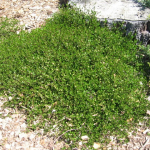
Muehlenbeckia axillaris, commonly known as Creeping Pohuehue or wire vine, is a low dense ground cover, forming wiry mats up to about 1 m in diameter. It spreads along the ground and even underground. It flowers prolifically in summer with masses of small creamy flowers. The flowers are yellowish white, 4-8 mm in diameter, and borne in groups of up to 3 in the axils. Male and female flowers often occur on the same plant and the female flowers form small opaque white fruit. Provides habitat for native copper butterflies. Birds and geckos love the fruit.
This groundcover has stems and small dark green leaves. Muehlenbeckia axillaris has thin wiry red-brown stems, with small dark green leaves that are less than 1 cm in diameter, and 2–4 mm thick. Prefers full sun. Tolerant of hot, dry conditions. Evergreen. Hardy.
Muehlenbeckia axillaris is primarily grown as an ornamental plant for its unique growth habit and attractive foliage. It is often used in rock gardens, coastal gardens, or other landscapes where its trailing habit can be appreciated. It is also used in erosion control and habitat restoration projects due to its ability to stabilize soil and provide cover for wildlife.
Habitat: Found in subalpine rocky places, riverbeds and and grasslands.
Flowering: Summer [November - April]
Fruiting: Autumn [December - April]
Tags: ErosionControl, Rongoa
Muehlenbeckia complexa (Scrambling Pohuehue)
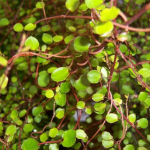
Muehlenbeckia complexa, commonly called scrambling or small-leaved Pohuehue, is quite vigorous and probably the best species for trimming and topiary. It is semi-deciduous, losing most, or all of its leaves over winter. Grows to 4m or more up suitable supports, and produces swollen white berries with black seeds. Leaves turn bronzy before dropping in late fall/early winter. Any reasonably well drained soil will suit this agreeable groundcover, and it'll tolerate drought, salt spray, and wind. Often found growing in the company of Plagianthus divaricatus.
M. complexa can form dense springy mounds, useful for suppressing weeds. In its native environment, it plays a key role in sealing human and natural disturbances on the forest edge. It also suppresses the growth of introduced weeds, such as blackberry, and promotes increased insect diversity. A wide variety of insect species are associated with M. complexa. It is an important host plant for several endemic species of copper butterflies including the coastal copper (Lycaena salustius). It is also a food source for lizards and birds such as tui, bellbird and kererū, which also feed on the buds and leaves.
Habitat: Found along rocky coasts as well as inland in coastal and montane forests.
Flowering: Spring - Autumn [October - June]
Fruiting: Winter [July - September]
Tags: ErosionControl, PoorSoils, Rongoa
Olearia avicenniifolia (Mountain Akeake)
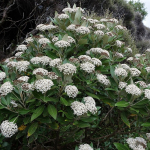
Olearia avicenniifolia, or Mountain Akeake, is an autumn flowering shrub - sweet showy, daisy like flowers. Silver / green large leaf. Very hardy bushy shrub tolerates exposure and dry sites.
Habitat: Occurs in scrub from sea-level to 900m.
Flowering: Autumn [January - April]
Fruiting: Autumn [February - May]
Olearia paniculata (Akiraho, Golden Akeake)
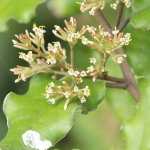
Olearia paniculata, Akiraho, is a rounded small tree with yellowish-green wavy leaves. Flowers small, white, in dense clusters. Fragrant sweet-scented flowers are borne in autumn. A good shelter plant. Hardy and tolerant of coastal conditions.
Due to its attractive appearance and hardiness, Olearia paniculata is sometimes cultivated as an ornamental shrub in gardens and landscapes. It can be utilized as a hedge, specimen plant, or included in mixed border plantings.
Habitat: Found in scrub east of East Cape to south Canterbury
Flowering: Autumn [March - May]
Fruiting: Winter [April - July]
Tags:
Ozothamnus leptophyllus (Tauhinu, Cottonwood)
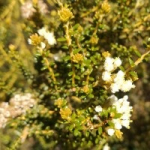
Ozothamnus leptophyllus, commonly called Tauhinu or Cottonwood, is a bushy shrub with small silver green leaves with fine silver hair beneath. The stems silver/white in colour. It has an attractive silver-grey appearance and flowers in profusion with clusters of tiny cream daisy (wheel-shaped) flowers followed by down-covered seed heads.
Ozothamnus leptophyllus is fast-growing, reaching its maximum height of 2 metres in 10–15 years. Tauhinu can readily colonise bare hillsides and pasture, with seeds readily dispersed by the wind. It grows rapidly, acting as a nursery plant for other species. Unless their under storey plants are heavily grazed, tauhinu shrublands are usually overtopped by taller shrubs and trees. Because of this, Tauhinu makes an excellent coastal or dry woodland revegetation plant. Seeds readily dispersed by the wind. It prefers a sunny location and is frost hardy.
Habitat: Found in coastal to subalpine shrubland.
Flowering: Summer [December - March]
Fruiting: Autumn [March - April]
Tags: PoorSoils
Phormium cookianum (Wharariki, Mountain Flax)
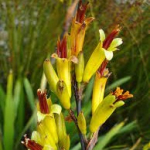
Phormium cookianum, Wharariki, is commonly called Mountain Flax, is a superb species, one of the hardiest and the most striking. Long arching green leaves all year round, and 2 metre long flower stalks over summer - particularly attractive to native birds. Use as a 'groundbreaker' in new gardens, en masse on banks. Foliage and flowers are great for floral artwork.
Phormium cookianum is a flax up to 1-3 metres tall but generally smaller than Phormium tenax. The numerous leaves are 5-12cm wide, thick, fibrous, droopy, and rise from fan-like bases. The tubular 25-40 mm long flowers are a dull pink or yellow colour. The seed capsule is pendulous and twisted.
Habitat: Strictly confined to subalpine, alpine situations, where it mainly grows on cliffs and mountain slopes, in seepages, along stream sides or on the margins of bogs.
Flowering: Spring [October to December]
Fruiting: Summer [January to March]
Tags: Coastal, DrainField, Rongoa
Phormium tenax (Harakeke, Swamp Flax)
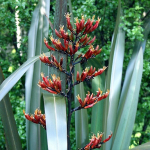
Phormium tenax, Harakeke, commonly called Swamp Flax, is one of the oldest plant species in New Zealand and it is unique to New Zealand. With its sword-shaped leaves it is a common feature of the New Zealand landscape. It grows up to 2 -3 metres high and its flower stalks can reach up to 4 metres. The flowers are brownish red in Summer, followed by black seed pods that stand upright from the stems. It is very hardy and fast growing with wide environmental tolerances. It will grow in dry and wet conditions, withstand strong and coastal winds and are frost hardy. It is used for hedging or shelter and in mixed native planting. It is also a pioneer plant meaning it should be one of the species planted first in a restoration planting plan as it establishes quickly when planted and shelters other plants.
Plant communities that include Apodasmia similis, Carex maorica, Carex secta, Carex virgata, and Eleocharis acuta often contain Phormium tenax.
History of use: Traditional uses of flax No fibre plant was more important to Maori than flax. Each pa or marae typically had a pa harakeke or flax plantation. Different varieties were specially grown for their strength, softness, colour and fibre content. Traditionally when harakeke leaves were removed from the plant, only the older leaves on the outside were taken. It is believed the three inner layers of the plant represented a family. This outer layer represented the grandparents, whereas the inner layer of new shoots or the child remained to be protected by the next inner layer of leaves, the parents. The uses of the flax fibre were numerous and varied. Clothing, mats, plates to eat off, baskets, ropes, bird snares, lashings, fishing lines and nets were all made from flax. Babies were even given rattles made from flax. Other parts of the plant were also used. Floats or rafts were made out of bundles of dried flower stalks (kokari). The abundant nectar from flax flowers was used to sweeten food and beverages. Flax also had many medicinal uses. The sticky sap or gum that flax produces was applied to boils and wounds and used for toothache. Flax leaves were used in binding broken bones and matted leaves were used as dressings. Flax root juice was routinely applied to wounds as a disinfectant. Today, flax is used in soaps, hand crèmes, shampoos and a range of other cosmetics. Flax seed oil can also be found for sale.
Habitat: Common from lowland and coastal areas to montane forest, usually but not exclusively, in wetlands and in open ground along riversides.
Flowering: Summer [November to December]
Fruiting: Summer [January to March]
Tags: ErosionControl, Rongoa, Wetland
Pittosporum eugenioides (Tarata, Lemonwood)
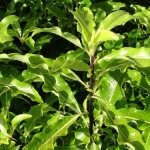
Pittosporum eugenioides, Tarata, commonly called Lemonwood, is a bushy tree ideal as a specimen or for hedging. Lemon scented foliage and fragrant flowers (spring).
Great in a windy position and also provides a barrier for the surrounding more intolerant plants. Pittosporums can be excellent stand-alone features, hedges, screens, windbreaks, shrubberies or topiary specimens. The highly ornamental, evergreen foliage almost always looks well-groomed and responds well to pruning. Frost tender when very young. Prefers a sunny to part shade position, does not mind the wind, and thrives in soil with good drainage. Tarata is somewhat drought-resistant therefore rainfall is not a major factor in its survival.
It has proved to be a great plant for establishing a quick canopy in a restoration project. It then provides an opportunity to introduce understory, shade loving plants to the same location, later planting underneath the lemonwood trees. Lemonwood is on the recommended list for replanting “small trees up to 6m.”
History of use: Maori used the gum from the bark in complex scent formula along with parts of other plants.
Habitat: Common tree of regenerating and mature forest in coastal to montane situations. It is found in forest clearings and along forest margins up to 600m above sea level.
Flowering: Spring [October - December]
Fruiting: Autumn [March - May]
Tags: ErosionControl, Rongoa
Pittosporum tenuifolium (Kohuhu, Black Matipo)
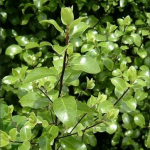
Pittosporum tenuifolium, Kohuhu, commonly called Black Matipo, is endemic and widespread throughout New Zealand. It is an extremely popular, adaptable and fast growing. Shiny light-green foliage with wavy margins and reddish brown branchlets. Fragrant dark red flowers in spring. Excellent plant for hedging and shelter. Tolerates wind, drought, frost, coastal conditions. A key species for forest revegetation and also a useful riparian edge plant. Kōhūhū grows particularly quickly at forest edges located at the bottom of high terraces. Sun or shade. Hardy. Evergreen.
The flowers’ colour ranges from dark-red to dark-purple turning almost black as the flowers age. Nectar fills the flowers. The flowers exude a honey-scented fragrance in the evenings with the scent being more obvious in slightly damp conditions. This attracts moths and night-flying insects, New Zealand’s indigenous pollinators. Fertilised flowers develop into small fruits that blacken as they ripen.
Habitat: A small tree of coastal to montane shrubland and forested habitats. Preferring successional habitats.
Flowering: Spring - Summer [October - January]
Fruiting: Autumn [February - May]
Tags: ErosionControl, Rongoa
Plagianthus divaricatus (Makaka, Salt Marsh Ribbonwood)
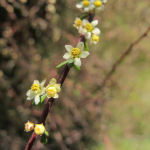
Plagianthus divaricatus, commonly called Salt Marsh Ribbonwood, is a dense twiggy shrub with small narrow leaves. Small sweetly scented flowers. Good hedging, deciduous, cold hardy. Will tolerate salt winds and wet soils. It can be found in association with (but not limited to) Coprosma propinqua, Muehlenbeckia complexa, Cyperus ustulatus, and Phormium tenax.
Found in sheltered coastal shorelines throughout New Zealand, in areas with salt swamp, sandy banks and throughout estuaries. As its common name suggests, it is salt and wet tolerant. As with P. regius, it has a juvenile and adult form where the leaves become larger as it grows. Used as a coastal wetland and restoration plant.
Habitat: Found alongside salty swamps or damp gravelly places in coastal regions.
Flowering: Spring [September - November]
Fruiting: Summer [December - March]
Tags: ErosionControl, Rongoa, Wetland
Poa cita (Wi, Silver Tussock)
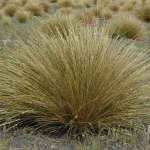
Poa cita, Wi, or Silver Tussock, is a densely tufted tussock of a graceful habit. Fine shiny silvery-green erect foliage with a flowing habit. Slender flowering stem, tawny coloured. Best in poor dry soils in an open situation. Excellent for mass planting. Great for exposed windy sites.
Habitat: Preferring a full sun position, tolerant of light shade, coastal conditions, and drought. Poa cita is often found in dry woodland and grassland plant communities
Flowering: Summer [November - December]
Fruiting: Summer [January - February]
Tags: PoorSoils, Rongoa
Raoulia hookeri (Golden Scabweed)
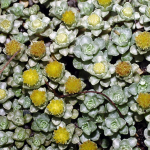
Raoulia hookeri is a small, mat-forming evergreen perennial with tiny, rosettes of silver, spoon-shaped leaves. Excellent in the rock garden.
The genus Raoulia is named after Étienne Fiacre Louis Raoul (23 July 1815–30 March 1852) who was a French naval surgeon and naturalist. On the ship L’Aube who was in Akaroa in 1840-41. He published a book Choix de plantes de la Nouvelle-Zélande ("Selected plants of New Zealand") in 1846. The genus was named after him by Joseph Hooker.
The Species hookeri is named after Sir Joseph Dalton Hooker (born 1817) a world famous botanist who travelled on the Antarctic expedition of 1839 under the command of Sir James Ross and wrote "Handbook of New Zealand Flora" published in 1864-67 describing many specimens sent to Kew by collectors. He died in 1911 and has a memorial stone at Westminster Abbey London.
Habitat: Dense mat forming plants found covering stone-strewn dry river and stream beds. Found in alpine dry rocky places and screes.
Flowering: Summer [December - January]
Fruiting:
Sophora microphylla (South Island Kowhai)
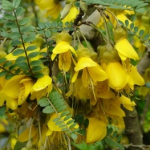
Sophora microphylla is also known as South Island Kōwhai, having showy yellow flowers in early spring. This particular Kōwhai has very small leaves (microphylla) and a tangled juvenile form, tending to straighten up and grow from an upright trunk at about four years. Kōwhai makes a good garden tree and is necessary for revegetation projects as a bird attractor. Kōwhai are suited to upper bank plantings of riparian areas. They also make beautiful shade or specimen trees. Semi-deciduous. Hardy.
Sophora microphylla have horn-shaped yellow flowers. The nectar is a favourite food for Tui, Bellbird and Kererū which also eat the leaves. The seed pods which appear after flowering stay hanging on the tree through winter.
Kōwhai is the national flower of New Zealand.
Habitat: In the North Island, especially the northern half this is a species of mainly riparian forest. South of Hamilton it can be found in a diverse range of habitats from coastal cliff faces and associated wetlands to inland grey scrub communities. Sophora microphylla and Sophora prostrata are the only forms naturally existing in Canterbury.
Flowering: Winter [August - October]
Fruiting: Spring - Summer [October - May]
Tags: Rongoa, WinterPollen
Veronica salicifolia (Koromiko, Hebe salicifolia)
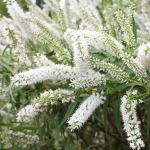 Sold Out
Sold Out
Veronica salicifolia, Koromiko, formerly called Hebe salicifolia, is a fast-growing large, spreading shrub. Provides good low shelter and is an excellent revegetation plant. It has showy white to pale lilac drooping flowers and willow-like foliage. Prefers a moist soil. Trim after flowering in a garden setting.
Veronica salicifolia is a hardy plant but isn’t tolerant of shade and needs to be grown in full sun and in a sheltered area with well-drained soil. It can, however, tolerate wet areas and can often be found on the edge of bush and wetlands. Once established they have considerable drought and frost tolerance.
History of use: The Māori utilized the plant’s medicinal properties for centuries. The leaves were chewed to help cure diarrhoea and applied to the skin to aid ulcers and wounds. Koromiko is the general name for the Hebes in Te Reo and is shared over a range of New Zealand Veronica species.
Habitat: Occurs from sea-level to close to the treeline, mostly in open sites, and forest margins. Is used in lower bank riparian edges where their roots can dry between rain events, but the soil stays damp.
Flowering: Summer [December to May]
Fruiting:
Tags: Rongoa
